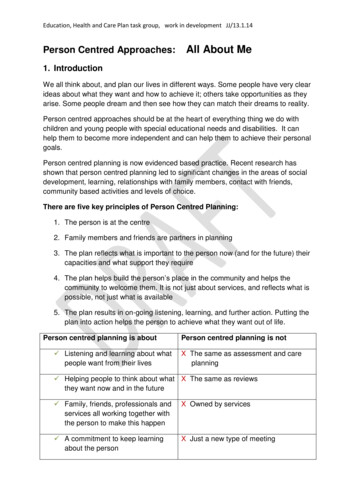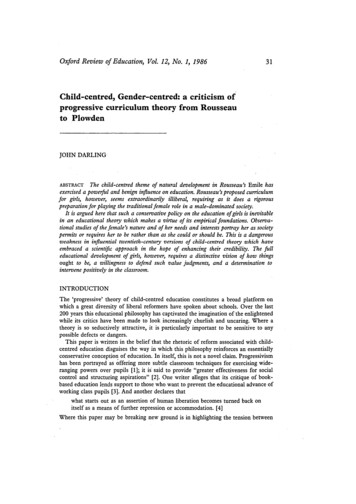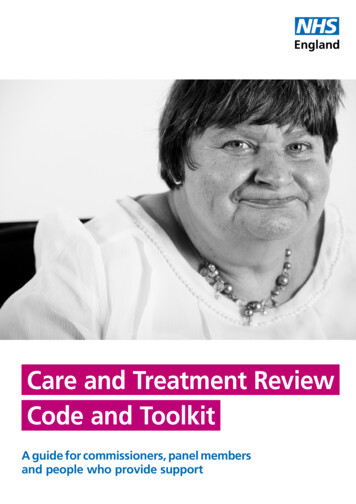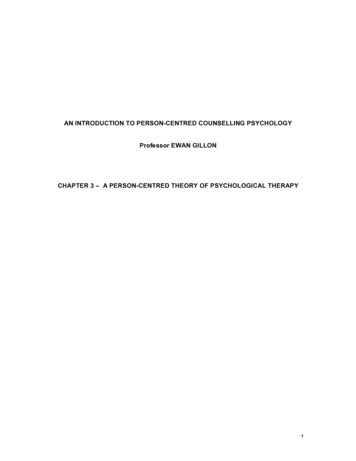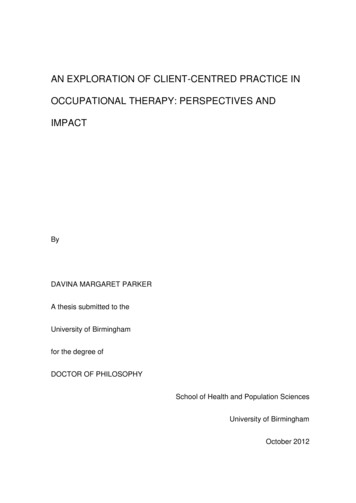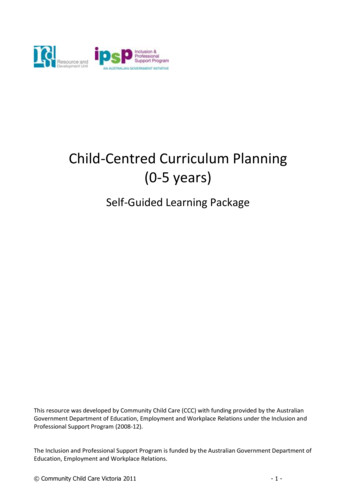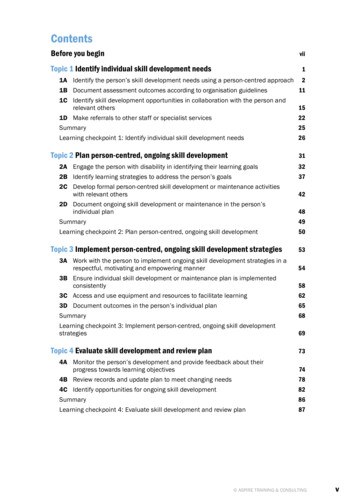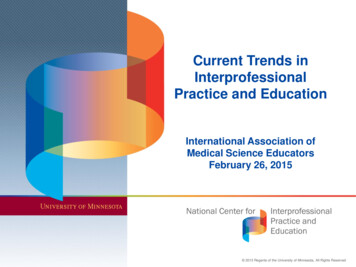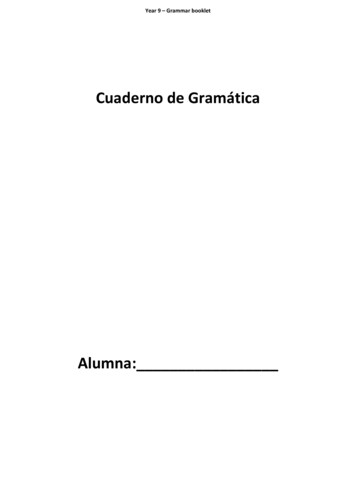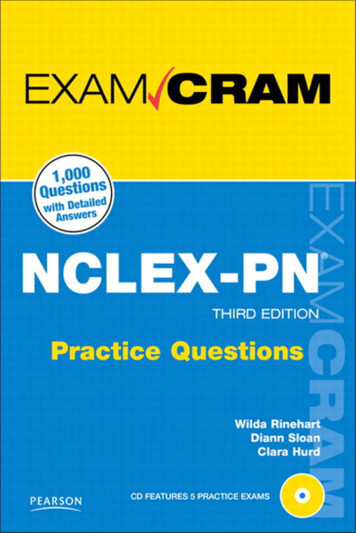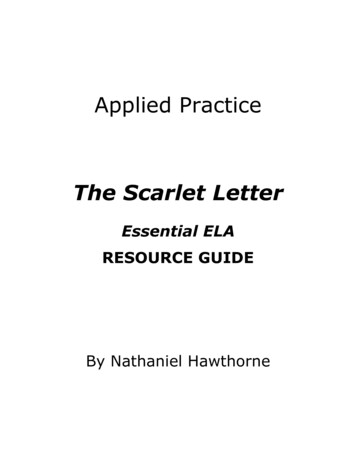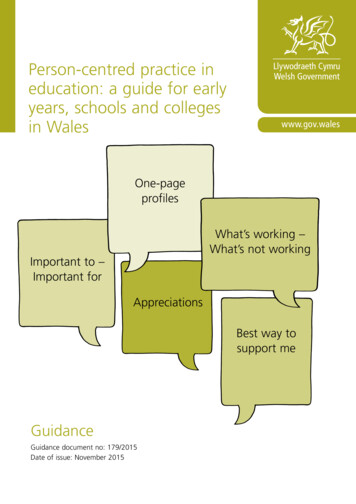
Transcription
Person-centred practice ineducation: a guide for earlyyears, schools and collegesin WalesOne-pageprofilesWhat’s working –What’s not workingImportant to –Important forAppreciationsBest way tosupport meGuidanceGuidance document no: 179/2015Date of issue: November 2015
Person-centred practice in education:a guide for early years, schools andcolleges in WalesAudienceAll schools, colleges and pre-school settings.OverviewThis document provides guidance and examples of how personcentred practice can be used in education settings to support learnersaged 0–25.ActionrequiredThis is recommended good practice.FurtherinformationEnquiries about this document should be directed to:Support for Learners DivisionInfrastructure, Curriculum, Qualifications and Learner SupportDirectorateWelsh GovernmentCathays ParkCardiffCF10 3NQTel: 029 2082 5789e-mail: tionalcopiesThis document can be accessed from the Learning Waleswebsite at gov.wales/learningRelateddocumentsTwo other guidance documents on person-centred practiceare available from the Learning Wales website.Developing as a person-centred organisation g enPerson-centred reviews toolkit ll/person-centred-reviewstoolkit/?lang enGraphic images reproduced by permission of Julie Barclay. TheAspirations graphic on page 42 is reproduced by permission ofJon Ralphs. The graphics were not created specifically for thesedocuments.2Person-centred practice in education Crown copyright 2015WG25916Digital ISBN 978 1 4734 4270 2
ContentsIntroduction2Person-centred thinking in practice in Carmarthenshire6One-page profiles11Appreciation tool31Good day – bad day36Aspirations42What’s working and not working47Communication charts53Decision-making profiles and agreements59Relationship circle64Learning logs684 plus 1 tool72Summary of person-centred thinking tools77More information about person-centred practice78Person-centred practice in education 1
IntroductionThink of a class you know well. Now think of the learner in thatclass whom you know the least. Are you sure that they are learningas well as they can? Do they have strengths and talents you areunaware of? Is something holding them back that you could address,if only you knew more about it?We all know it is easier to teach and support learners when weunderstand them, and this is why person-centred approaches are atthe heart of the best education practice today. That’s the theory atleast – but how can we apply person-centred practices every day inour schools and colleges and make them work for everyone?This guidance describes a range of person-centred thinking toolsthat will help you to work individually with the learners you teachand support. They are practical and easy to use, and they give youinformation that you can use directly in the classroom and beyond.Above all, they focus on what is important to an individual, allowingyou to understand what matters to them, and to discover thebest ways to support them. You won’t simply end up with a listof challenges or problems to overcome, because you will gatherand share what is most important to and for learners, from theirperspective and from that of the people close to them. You will havea rounded picture that really is centred on that individual.The Welsh Government has commissioned a set of resources topromote and support the development of person-centred practicein early years, schools and colleges. In this publication, we describe10 key person-centred thinking tools that can be used with learners,parents, staff and governing bodies.In addition, there are two more publications that will help anyeducation setting to become a person-centred organisation: a self-assessment tool to help you identify your current level ofperson-centred practice and plan suitable next steps a toolkit providing practical guidance on how to run effectiveperson-centred reviews, including preparation booklets forlearners, their families and professionals.All these publications are available as free downloads from theLearning Wales website at gov.wales/learning.2Person-centred practice in education
What difference will using these thinking tools make?If you use person-centred practices in every aspect of your school orcollege’s life, you will find that all your learners learn more effectively,because their learning reflects their individual strengths and interests.Relationships will be more productive and positive. Staff, learners andparents will find it easier to share information and communicationwill flow more easily.If you are involved in carrying out person-centred reviews, thethinking tools in this book make it easy to gather the informationyou need, to reflect on what you have discussed, and to focuson the actions you want to take. They allow you to take aninformal approach to review meetings so that they are relaxedand unthreatening for everyone, while giving you a thorough andsystematic means of running really effective reviews that lead toproductive planning, action and outcomes which make a powerfuldifference to learners’ lives.What can you use the thinking tools for?You can use these thinking tools to gather and share information,and to plan and monitor your actions, throughout your school orcollege. You can use them with learners, staff, governors – anyonewho is involved in the life of your school. Some schools and collegesinitially create one-page profiles for a small group of learnerswho may need some extra support. Other schools create one-pageprofiles for every learner in a class, or a year, or even the wholeschool. You can start small and build on your experience, or you canstart big if you want everyone involved and excited straight away.Many schools start by getting staff to create their own one-pageprofiles together. By doing this, they learn about the process fromtheir own experience. They also often find that their colleagues haveskills and talents they hadn’t suspected, allowing them to supporteach other far better, and building a far stronger team as a result.How do you get started?A good place to start is the one-page profile, because it’s sucha powerful and effective way of gathering and sharing the mostimportant information about an individual. The next steps are upto you.Person-centred practice in education 3
You can use the tools in any order, and revisit tools over a periodof time. You will find that using the tools generates informationthat you’ll want to add to the one-page profiles, and this is usefulbecause a one-page profile is a dynamic tool that should reflectchanges, growth and developments.What is each tool for?These 10 person-centred thinking tools can be used in any order,though many schools and colleges start with a one-page profile.On the other hand, each thinking tool offers a valuable way ofgathering information that could be included in a one-page profile,so you may decide to start with, for example, the appreciationthinking tool.One-page profilesThe foundation of person-centred support, a one-page profilecontains key information about an individual’s character, gifts andtalents; what is important to them; and the best way to supportthem.Appreciation toolThis tool is used to gather information on what others like andadmire about an individual; their gifts, talents and interests.Good day – bad dayThis tool is used to gather information on what makes an individual’sday good or bad, and what you can do to make sure they have moregood days than bad days.AspirationsHelps you to find out, based on an individual’s gifts and talents, whatis important to them, what they want to be, and what they want todo. What steps can they take?What’s working and not workingA snapshot from different people’s perspectives of how things are,what’s working well, and what needs to be different. It can focus onone small area of the learner’s education or be more general.Communication chartWhat is this individual communicating through their behaviour, andhow do they want you to respond?4Person-centred practice in education
Decision-making profiles and agreementsA picture of the decisions a learner makes, how they make them,and the support and information they need.Relationship circleA visual summary of who is important in an individual’s life.Learning logA record of an individual’s learning that helps you see what needs tostay the same and what needs to change.4 plus 1A thinking tool that helps you reflect on what has happened bylooking at what you’ve tried and learned, are pleased about andconcerned about – and then helps you decide what you’ll do next.In the next section, a practitioner describes her own experience ofintroducing person-centred thinking. After this, in the following 10sections you can find out what each thinking tool can do for you andyour learners, and how to use each one.Person-centred practice in education 5
Person-centred thinking in practice inCarmarthenshireHelen Etherington is a Senior Educational and Child Psychologistworking in Carmarthenshire. Here, she reflects on her experience ofusing person-centred thinking tools, both in schools and colleges,and in her own practice.Introducing one-page profiles in a primary schoolCarmarthenshire local authority was one of the original countiesinvolved in the Welsh Government’s ‘Statements or SomethingBetter?’ programme, and led the development of a person-centredapproach within the participating schools. One of Carmarthenshire’sschools, Burry Port Primary School, embraced the approach and,following initial whole-school two-day training, the headteacherdecided to develop one-page profiles for all the learners, not onlyfor those identified as having additional learning needs.Why one-page profiles?Following the whole-school training, all members of staff were verypositive about the potential use of one-page profiles to: support learners’ learning reflect ‘pupil voice’ support transition across the key stages provide key information for supply teachers.I attended twilight sessions at the school on the development ofone-page profiles. Individual members of staff (both teachersand learning support assistants (LSAs)) brought examples ofone-page profiles they had developed with the learners. Initially,these were produced only with learners who had statements ofspecial educational needs (SEN). However, over the period of oneacademic year, the practice was expanded to include all learners.6Person-centred practice in education
Recognising success1. The school has developed one-page profiles for all learners.Teaching assistants and teachers also visit pre-school learners andtheir families to develop one-page profiles, resulting in learnersentering the nursery at the school with one-page profilesalready in place.2. The relationship between home and school has generallyimproved due to increased communication. One-page profilesare shared with parents during parents’ evenings, and they aresent home with the end of year reports.3. Members of staff at the receiving secondary school, whichwas also involved in the ‘Statements or Something Better?’programme, have commented positively on how the one-pageprofiles have been effective in supporting transition.4. Information obtained from educational and child psychologyconsultation records is also used to update the one-page profile,together with advice from other supporting professionals.5. Members of staff have become more focused on what isimportant to learners, and teaching activities have beendeveloped to reflect this.6. Learners are more actively involved in decisions made about thesupport they receive at school.7. The one-page profiles are used to promote self-esteem.Problems and how they were overcomeInitially, there was some inconsistency around the one-pageprofiles; however, following the twilight session, when membersof staff were requested to bring examples with them to share, thequality of one-page profiles improved considerably.What could be done differentlyI would break down the two-day training into more manageablechunks, e.g. focusing on one-page profiles specifically inone session in order to reinforce the importance of using theperson-centred tools (e.g. good day – bad day, etc.) to developthem. This could also be achieved through getting e-learning andcoaching staff to utilise this in the classroom.Person-centred practice in education 7
A more person-centred approach to educational andchild psychologyI have adapted my paperwork to reflect a more person-centred wayof working. My educational and child psychology consultation recordis now organised under the person-centred headings, and I try toconduct all of my conversations with learners and their parents in aperson-centred way.The thinking tools and practices usedI used these thinking tools.1. Appreciation2. Important to/for3. What’s working and not working4. What could be betterI have found that I can record the majority of information I needunder these headings, and that actively applying them in myconsultations helps me to focus on the needs and wishes of thelearners. I also wanted to ensure that I was involving the learners Iwork with as much as possible in identifying the support they feelthey need.I usually use good day – bad day to try to ascertain what isimportant to someone, and how to support them, although I alsofind relationship circle particularly useful when trying to identify akey individual who may be able to effect change.Recognising success1. Schools have commented that they prefer this new method ofrecording information. They feel that it is presented in a clearway, and that it supports the ‘pupil voice’. On some occasions,the information has encouraged schools to address issues in lesstraditional ways, and adopt a more solution-focused, collaborativeway of supporting learners based on their interests and whatmotivates them.2. Schools have started using the information in my consultationrecords to update their one-page profiles.8Person-centred practice in education
3. Parents also appear to be happier with this way of reporting,particularly with the focus shifting towards the positive, i.e.what the learners can do, and the development of practicalinterventions which take into consideration the learners’viewpoints, and the parents’ viewpoints.4. Tools such as good day – bad day and routines have helpedme to identify key pieces of information which may not havebeen obtainable through direct questioning techniques or throughother methods of assessment. The rich information provided hashelped to build up a far clearer picture of the holistic learner andhow they are pivotal in their own learning.5. Some schools have gone on to develop one-page profiles fortheir learners using the information outlined in the consultations.Problems and how they were overcomeAll the schools, parents and learners I have worked with appear tohave embraced this person-centred way of recording information.There was, on occasion, some resistance, mainly governed by currentcriteria-led LA systems, to this needs-led approach, but I feel positivethat this culture shift is beginning to gain momentum. The leadershipof headteachers in resolving these issues was crucial.What could be done differentlyI think I would involve learners and their parents in the developmentof person-centred paperwork for the Carmarthenshire Educationaland Child Psychology Service. This would help to identify what thelearners themselves and their families would find useful in termsof recording assessment, identifying appropriate interventions andevaluating progress.What person-centred thinking felt like at PennaethSchoolAlison Williams is headteacher of Pennaeth School – the schoolthat Helen describes above. Here is her experience of the power ofperson-centred approaches.Person-centred practice in education 9
‘As a parent of a child who had a statement of SEN while in school,I attended around seven annual review meetings. I am certain thatthe professionals involved in those meetings did their best to makeme feel comfortable. However, I often felt intimidated by the largenumber of professionals around the table, who all seemed to betelling me what my child could not do or found difficult.As an education professional, I had a full understanding of the jargonand educational terms being used and the implications of those onmy child’s learning and development. As a parent, I often foundmyself burying my emotional response to the more objective views ofmy child held by those professionals.Working with parents through a person-centred approach alwaysbegins in a positive way with a celebration of what makes the learnerunique and valued. Target-setting is close to the actual needs ofthe learner and therefore more easily attainable, with all presentfully accountable and committed to success. Parents, learners andprofessionals are equal partners and the approach is carried out withthe learner at the centre.At our school, we have a number of families who have been involvedin this approach for some time. They now have strong relationshipswith professionals that promote open dialogue and problem solvingfor the success of the learner. Parents have commented positivelyon the approach, in particular the way that it builds trust and strongrelationships across professions and communities.In many cases, it has empowered parents and ensured their fullunderstanding of the support in place and the progress their child ismaking.As a school, we are now seeking to work in a more person-centredway with families experiencing issues that affect the learner’sattainment or engagement in school. For example, we use personcentred approaches when we identify and refer families for supportwhen social or health needs affect the learner’s attendance.’10 Person-centred practice in education
One-page profilesImportant to/important forGetting a balance of what is important to and for a learner underpinsperson-centred practice. All too often documents, plans and reviewsfocus on what is important for a learner – the things that teachersand other professionals think the learner needs in order to learn.Person-centred practice brings the focus back onto the learner.Finding out what is important to and for a learner is at the heart ofcreating their one-page profile, and later in developing outcomesand actions in person-centred reviews.Important toWhat is important to a learner includes the things that really matterto them, that give pleasure and meaning, and provide quality oflife. If these things aren’t present the learner may feel anxious orunhappy. For example, a learner might say that spending timewith their friends out of school or sitting near the door in class isimportant to them. If these things didn’t happen, they might feelunsettled or upset.Important forWhat is important for a learner includes those things that musthappen in order for learners to progress in their education, develop,and stay healthy and safe. These are often described by professionalsas ‘assessed need’. For example, it might be important for a learnerto have a particular differentiation of a lesson, or to have things helda specific distance in front of them in order to be able to focus onthem. Understanding what is important for a learner means you candescribe the best way to support them – it is information on howbest to support them that is included in their one-page profile.Balancing important to and important forWe all have to balance what is important to us and what is importantfor us – it’s a familiar compromise we make every day. For example,we may have to find a balance between wanting to eat chocolateand needing to maintain a healthy weight, or between wanting arelaxing evening and wanting to get fitter at the gym.The one-page profile helps you to describe this balance for alearner by setting out clearly what is important to and for them inone place.Person-centred practice in education 11
Using the important to/for thinking toolWhen working with a learner, you need to find out: what is important to the learner? what is important for the learner?These questions are deceptively simple. As well as the fundamentalimportant to/for thinking tool, which we give completed exampleson pages 13 and 14, you can use a range of other person-centredthinking tools to gather this information. Conversations aboutwhat makes a good day and a bad day, routines, relationships andpossessions can all contribute to identifying what is important to andfor a learner. There is more information about how to do this in thefollowing sections.Important to12 Person-centred practice in educationImportant for
Examples of the important to/for toolLauraLaura is 17 and attends her local college. These are some of thethings that she describes as being important to and for her.Important to meImportant for meTo be on time or early for college. To be reminded to have a restand take breaks when I amTo be organised, to pack my bag studying.the night before.That my tutors know I haveTo have everything I need for the autism and how to support me.day.For tutors to offer me help whenTo have my breakfast – I amI am looking down in lessons.really fussy and only like a cerealbar.To have information brokendown into steps.To always have a back-up plan.I can struggle in group work butTo make sure I have myknow it is good for me – it helpshomework done and to hand it if I get to know people first.in on time.To have somewhere quiet torelax if I am stressed.Not to have too much workgiven to me at once.When you add information like this to a one-page profile, you needto develop it more fully. See the following examples.To be on time or early for college.This could be written in the ‘important to’ section as:‘I like to arrive at college on time, as I dislike being late. It also givesme time to catch up with my friends before lessons start. I catch the8.15a.m. bus, which gets me to college by 8.40.’For tutors to offer me help when I am looking down in lessons.This could be written in the ‘how best to support’ section as:‘When I am anxious or I don’t understand something, I will lookdown and not make eye contact. If you see me do this, ask if I needany help, and I will explain what my problem is.’Person-centred practice in education 13
CaitlinCaitlin has more profound and complex needs. Professionals, familyand friends who know her well have described what they think isimportant to and for her. They can make ‘best guesses’ about whatis important to her based on observing her reaction to things. Theyknow that she enjoys swimming because she gets excited when sheis told she is going, and smiles and is happy in the water. They knowwhat is important for Caitlin based on their professional opinion orknowledge of Caitlin. They know what will help and support her toprogress, stay healthy and safe. Here are some examples of what isimportant to and for her.Important to CaitlinImportant for CaitlinSpending time at home with her To use her wheelchair whenmum, dad and brother Tomos.outside.Getting out and about locally,especially to cafés, restaurants,shops and the cinema.To go swimming or use thehydrotherapy pool.Listening to quiet, relaxingmusic.To be supported while walkingto keep her from falling.To have support with hercommunication.Not to eat quickly or have largepieces of food on her plate.To be told in advance of anychanges to routine.On Caitlin’s one-page profile, you could develop these statementsas follows.To go swimming or use the hydrotherapy pool.This could be written as:‘To go swimming or use the hydrotherapy pool at least once a week.I prefer to go when it is quiet and with a small group as lots of noisemakes me anxious.’To be supported while walking.This could be written as:‘Caitlin is unsteady on her feet. Support her when walking byholding onto her right hand and placing a hand on her left shoulder.’14 Person-centred practice in education
Why use one-page profiles?The one-page profile is the foundation of personalised educationsupport. It gathers key information about a learner so it can bequickly shared and understood.A one-page profile describes a learner’s character, gifts and talents;what is important to them; and the best way to support them.You can find an animation describing what one-page profiles looklike and how they can be used in many contexts at https://www.youtube.com/watch?v fnaKnVWFh44The one-page profile is a powerful tool, and individuals andorganisations across all sectors are using it to transform the way theywork.How to use one-page profilesThe elements of a one-page profileThere are three elements in a one-page profile. Appreciation: what people like and admire about the learner;their character, gifts and talents. What is important to the learner: what matters to the learner,from their perspective? How to support the learner: expertise about how to get the bestout of the learner, from the perspective of the learner themselvesand their family, teachers and other staff.Your aim in creating a one-page profile is to discover what supporta learner needs, and to balance this with what is important to thelearner.Person-centred practice in education 15
One-page profileWhat people appreciate about me(like and admire)What’s important to meHow to support me16 Person-centred practice in education
Using thinking tools to gather informationYou can gather the information for a one-page profile in a rangeof ways. You can use other thinking tools in this book to discoverinformation for the profile.Use the appreciation thinking tool to find out what others like andadmire about the learner.Use the good day – bad day, aspirations, what’s working andnot working, and relationship circle thinking tools to find outwhat and who matter most to the learner.Use the good day – bad day and what’s working and notworking thinking tools to find out how best to support the learner.See ‘Summary of person-centred thinking tools’ on page 77.Guess, ask and writeIt can take time to find out what matters to each learner. Youwill discover information through conversations and by observingbehaviour – sometimes while using a thinking tool, sometimes duringeveryday interactions.GuessStart by noting down what you think you already know about thelearner – what do they seem passionate about? What makes themlaugh and smile? What makes them sad or angry? What do theyshow no interest in at all?AskNow you need to find out if your guesses were right. Here are sixquestions to start conversations with the learner. You can adaptthem to suit the learner’s communication and understanding, and ifthe learner doesn’t use words to speak you can ask family, friendsand staff members who know them well. It’s best not to ask all thequestions in one sitting as this is a lot of information for one personto think about.1. Who are the most important people to you? Have a look togetherat their relationship circle if they have one.2. What would be your best and worst day?3. What do you usually do during the day, evening and weekend?Person-centred practice in education 17
4. What makes you feel better when you are unhappy, angry orupset?5. What would you never leave home without, e.g. in your bag orpocket?6. What would your family and friends say that they like, love oradmire about you?WriteOnce you are confident that you have understood the learner’sfeelings, you need to record them as accurately and specifically aspossible. Use the learner’s own words where you can.If the learner cannot tell you their feelings directly, you may need towrite down your best guesses. You can test your guesses by usingthe learning log and 4 plus 1 thinking tools.Tips on writing a useful one-page profileThere is no one way to make a one-page profile, but it is importantthat everything you write is accurate, clear and easy to read. Keep all the statements short and specific. Focus on the positive. Give enough detail so anyone can use the information straightaway.Here are some tips and examples of statements for each elementshown on an empty one-page profile.18 Person-centred practice in education
One-page profilePhoto of youngperson hereLike and admireThis element needs to be a positive, proudlist of the learner’s qualities, strengths andtalents.Avoid words like ‘usually’ or ‘sometimes’ oranything that sounds like faint praise.What’s important to an individualInclude enough detail so someone who doesn’t know the individual canunderstand what matters to them. If you took the names off the one-pageprofiles in a class, it should still be easy to identify everyone.Instead of this write thisLoves break timePlaying games (usually involving running and skipping)with Hannah and her other close friends at break times.Being organisedHaving her pencil case and school bag packed the nightbefore, and making sure her tray in class is tidy.Having friendsWalking to school with her friend Ella every day, and sittingwith Ella, Lucy and Nina at lunchtime.How to support an individual well at schoolInclude enough detail that a supply teacher could immediately support theindividual well and know both what to do and what to avoid.Instead of this write thisBe patient with Liam Liam may need you to repeat a task a couple of timesbefore he feels confident trying it. You can tell if he isunsure because he will look out of the window andchew his pencil. Asking if he has any questions about theactivity usually works better than asking if he understandswhat to do.Chloe needs helpChloe takes time getting to know people and makingfriends. It helps if you can find ways for her to spend herwith friendshipstime and sit with different girls in the first weeks of term.She appreciates you asking how her friendships are goingin one-to-one time.Person-centred practice in education 19
4 Person-centred practice in education You can use the tools in any order, and revisit tools over a period of time. You will find that using the tools generates information that you’ll want to add to the one-page profiles, and this is useful because a one-page profile is a dynamic t
